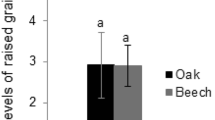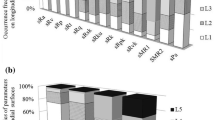Abstract
Sensory roughness is one of the most important factors that determines the quality and/or value of various wood products. The aim of the present study was to confirm whether the sensory roughness of coated wood surfaces could be estimated by the here proposed image analysis. Twelve white oak (Quercus alba) fancy veneer overlaid plywood samples were prepared with two types of grains and six coating specifications. Forty participants subjectively evaluated the sensory roughness of the samples by rubbing their surfaces without being able to see them. Sample surface images were acquired with a goniophotometric method and were submitted to an image analysis to calculate lightness differences (contrast) between relatively small areas as image characteristics. Three surface profile parameters were also measured based on the conventional stylus method. Three-way analyses of variance for the evaluation of sensory roughness revealed significant main effects of the coating specification and the rubbing direction. Although contrast and surface profile parameters were hard to estimate in terms of sensory roughness for spiny surfaces, both measures were well correlated to sensory roughness for porous surfaces. In particular, the linearity between the sensory roughness of the porous surfaces and contrast was equal to or greater than that of the surface profile parameters.







Similar content being viewed by others
References
Fujiawara Y, Fujii Y, Sawada Y, Okumura S (2001) Development of a parameter to reflect the roughness of a wood surface that corresponds to tactile roughness. Holz Roh Werkst 59:351–355
Fujii Y, Yoshizane M, Okumura S (1997) Evaluation of surface roughness by various parameters Ι. Relationship between several roughness parameters and tacitle roughness (in Japanese). Mokuzai Gakkaishi 43:574–579
Fujiwara Y, Inui K, Fujii Y, Sawada Y, Okumrua S (1998) An approach to the three-dimensional evaluation of the surface roughness of wood. Relationship between distribution of peaks on the surface and tactile roughness (in Japanese). Mokuzai Gakkaishi 44:447–451
Fujiwara Y, Fujii Y, Sawada Y, Okumura S (2004) Assessment of wood surface roughness: a comparison between tactile roughness and three-dimensional parameters derived using a robust Gaussian regression filter. J Wood Sci 50:30–40
Fujiwara Y, Fujii Y, Okumura S (2005) Relationship between roughness parameters based on material ratio curve and tactile roughness for sanded surfaces of two hardwoods. J Wood Sci 51:274–277
Hu C, Afzal MT (2005) Automatic measurement of wood surface roughness by laser imaging. Part I: Development of laser imaging system. Forest Prod J 55(12):158–163
ISO 16610-32 (2009) Geometrical product specifications (GPS)—filtration—Part 32: Robust profile filters: spline filters. International Organization for Standardization
ISO 25178-2 (2012) Geometrical product specifications (GPS)—surface texture: areal—Part 2: terms, definitions and surface texture parameters. International Organization for Standardization
JIS B0601 (2001) Geometrical product specifications (GPS)—surface texture: profile method—terms, definitions and surface texture parameters. Japanese Standards Association (JSA)
JIS B0671-2 (2002) Geometrical product specification (GPS)—surface texture: profile method; surfaces having stratified functional properties—Part 2: height characterization using the linear material ratio curve. Japanese Standards Association (JSA)
Lundberg IÅS, Porankiewicz B (1995) Studies of non-contact methods for roughness measurements on wood surface. Holz Roh Werkst 53:309–314
Nakamura M, Matsuo M, Nakano T (2010) Determination of the change in appearance of lumber surfaces illuminated from various directions. Holzforschung 64:251–257
Nakamura M, Miyake Y, Nakano T (2012) Effect of image characteristics of edge-grain patterns on visual impressions. J Wood Sci 58:505–512
Nakamura M, Nakagawa S, Nakano T (2015) Evaluation of visual impact of multiple image characteristics observed in edge-grain patterns. J Wood Sci 61:19–27
Ramanakoto MF, Andrianantenaina AN, Ramananantoandro T, Eyma F (2017) Visual and visuo-tactile preferences of Malagasy consumers for machined wood surfaces for furniture: acceptability thresholds for surface parameters. Eur J Wood Prod 75:825–837
Ramananantoandro T, Larricq P, Eterradossi O (2014) Relationships between 3D roughness parameters and visuotactile perception of surfaces of maritime pinewood and MDF. Holzforschung 68(1):93–101
Sadoh T, Nakato K (1987) Surface properties of wood in physical and sensory aspects. Wood Sci Technol 21:111–120
Sandak J, Tanaka C (2003) Evaluation of surface smoothness by laser displacement sensor 1: effect of wood species. J Wood Sci 49:305–311
Sandak J, Tanaka C (2005) Evaluation of surface smoothness using a light-sectioning shadow scanner. J Wood Sci 51:270–273
Sandak J, Tanaka C, Ohtani T (2004) Evaluation of surface smoothness by a laser displacement sensor II: comparison of lateral effect photodiode and multielement array. J Wood Sci 50:22–27
Author information
Authors and Affiliations
Corresponding author
Additional information
Publisher’s Note
Springer Nature remains neutral with regard to jurisdictional claims in published maps and institutional affiliations.
Rights and permissions
About this article
Cite this article
Nakamura, M., Kikuchi, Y., Hotta, S. et al. Evaluation of the sensory roughness of some coated wood surfaces by image analysis. Eur. J. Wood Prod. 76, 1571–1580 (2018). https://doi.org/10.1007/s00107-018-1342-8
Received:
Published:
Issue Date:
DOI: https://doi.org/10.1007/s00107-018-1342-8




